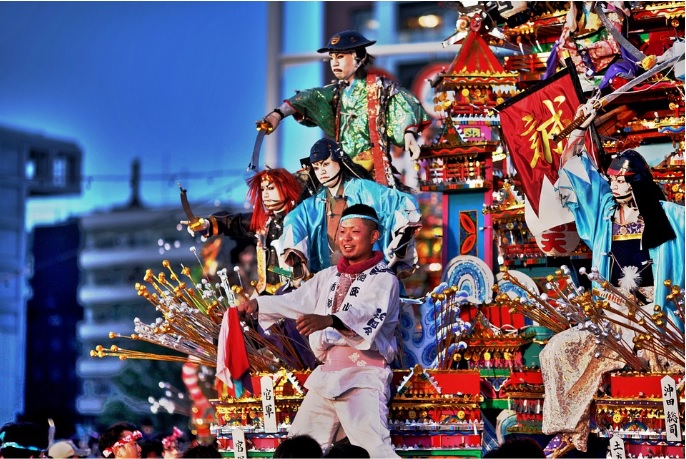
As the saying goes, “Behind every successful man is a woman.” And behind every successful hero are women creators.
Introducing Sayo Yamamoto and Mitsurou Kubo, the women who made the phenomenal skating anime, Yuri on Ice.
Sayo Yamamoto and her femme fatales
Yuri on Ice director Sayo Yamamoto and her signature sunglasses. Photo from AniDB.
Before Yuri on Ice, Yamamoto has already been making waves in the Japanese animation industry.
Graduating from the College of Art and Design in Tokyo, her final project was an animation about a samurai inspired by legendary actor, Toshiro Mifune. Her early career consisted of participating in a number of opening and ending themes for animes, namely, Texhnolyze, Rozen Maiden: Träumend and Arakawa Under the Bridge. She then proceeded to the actual anime production of animes like Kemonozume, Ergo Proxy, Gunslinger Girl, Samurai Champloo, and Redline.
Official poster of Michiko and Hatchin. Photo from Ipic Storage.
In 2008, she released her first directorial work, Michiko and Hatchin, under animation outfit, Studio Manglobe. The heroine in this anime was a self-proclaimed sexy diva named Michiko Marandoro. A femme fatale (a story archetype pertaining to strong-willed seductive women) by nature, Michiko was a criminal who just escaped a prison fortress. She then rescued the little girl named Hatchin from her abusive foster parents. Doing a tag team, the two made a decision to embark on a journey away from the cops and some cruel foster guardians.
Official poster of Lupin III: The Woman called Fujiko Mine. Photo from Wine and savages blogspot.
In 2012, she directed Lupin III: The Woman called Fujiko Mine with TMS Entertainment. Basing her work on the comic legend from Monkey Punch, Yamamoto decided to make Fujiko Mine the heroine of her franchise. This anime featured the misadventures of the seductive Fujiko up to the time that she met the group of Lupin III.
Mitsurou Kubo and her bishounens
Mitsurou Kubo, one of the creators of Yuri on Ice.
Before stepping on the ice skating rink, Mitsurou Kubo has made three serializations in Weekly Shounen, a manga magazine for young boys, and one in Evening, a seinen manga magazine, targetting older men.
Official manga cover of 3.3.7 Byooshi. Photo from Manga Updates.
All of her works so far featured bishounens or pretty leading men. Her first bishounen is Fukuda Shinichi, the captain of North Kanto Southern High's Cheerleading squad, from the 2001 manga, 3.3.7 Byooshi. The manga started with Fukuda’s trip to Tokyo and how he met his role model, Ume, the former captain of the cheerleading squad. The serialization lasted until 2003.
The following year, she released another shounen manga (a story for boys), featuring the bishounen lifeguard Hyogo Kanbayashi. He was working his way through the elite lifeguard team called Tokkyuu. This one ran until September 17, 2008.
Official manga cover of Moteki, volume 4.5. Photo from Wikipedia.
Two months after, she was published on another magazine, Evening. Moteki was about Yukiyo Fujimoto, a temp worker in Japan. One day, he just received tons of messages from all the women in his past and decided to meet them one by one. The manga ended in 2010.
Again!, her latest manga before Yuri on Ice, was about Imamura Kinichirou, a lonely school boy. The manga was published in Weekly Shounen from 2011 to 2014.
When femme fatales and bishounens combine
The official Yuri on Ice trailer.
So what do we get when we have combined the femme fatales of Yamamoto with the bishounens of Kubo? There came a sports series, which literally turned the world of anime into ice.
Following the release on October 6, the cold never bothered the world of otakus and easily got them hooked on the first episode.
The series had all the basic formulas that could make a hit anime: sports, bishounens, dreams, passion and a magnificent animation.
The anime explored the world of ice skaters and how they worked themselves so hard just to reach their dreams of winning the gold medal.
The characters of Yuri on Ice. Photo from Inverse.
There was Yuri Katsuki, the sensitive and mild-mannered 23-year old figure skater, who dreams of winning the Grand Prix. On the first episode, Yuri just lost a competition and he was experiencing a lot of anxiety due to his low self-esteem.
There was also Victor Nikiforov, the 27-year old Russian figure skating genius who won the Grand Prix five consecutive times. Yuri looked up to Victor but their world exceeded the boundaries of the skating rink.
And just like any other sports anime, the characters poured in a lot of strong will, pure determination and hard work to their passion.
Sprinkle those with extremely pretty boys with femme-fatale-like qualities of being seductive, confident and bold, Yamamoto and Kubo sure knew how to work around their formulas.
Yuri on Ice’s Victor Nikiforov. Photo from Tumblr.
But what made these two women creators exceptional was the daring decision to explore the topics of anxiety, self-doubt, depression and most controversially, LGBTQ (Lesbian, Gay, Bisexual, Transgender, and Queer) relationships.
As the story progressed, Yuri on Ice has promised not to constrict the characters to the activities inside the rink. The anime developed the love story between Yuri and Victor, and even included hints of marriage.
On December 21, the phenomenal pretty skaters finally said their goodbyes to the fans. What happened to the Grand Prix and the bromance? No, this article will not give any spoilers to those who haven’t caught the anime.
Banner image from Crunchyroll.
Sources:













